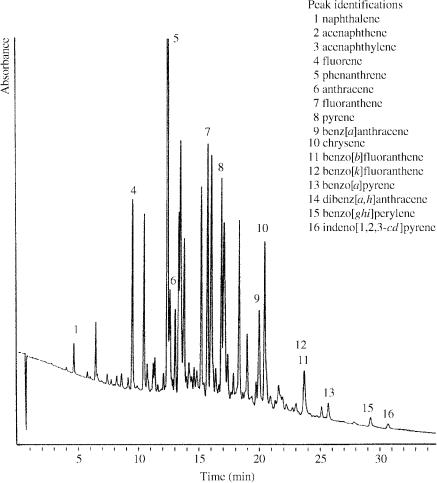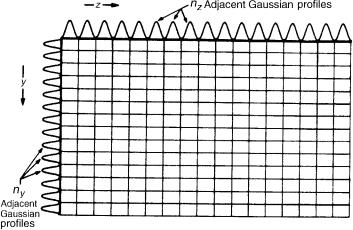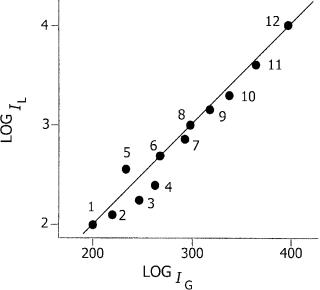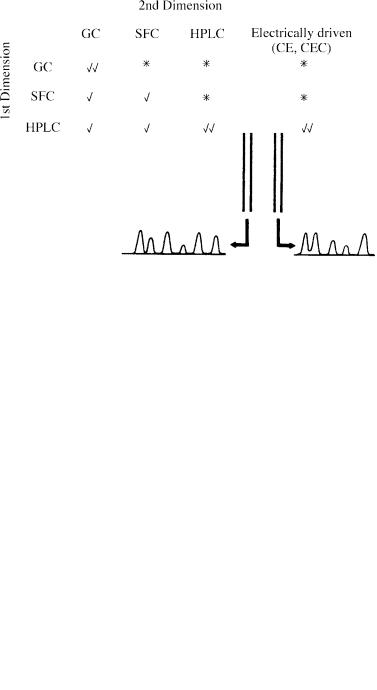
Multidimensional Chromatography
.pdf
Introduction |
7 |
that there is a considerable mismatch between the capabilities of even very long GC columns or small-particle HPLC columns and the requirements for the analysis of mixtures commonly met in petroleum, natural product or biological chemistry. For example, a GC chromatogram of gasoline on a 400 m long capillary column developing 1.3 106 plates in an 11 h analysis with a peak capacity of 1000 still showed (22) considerable overlap. In the case of HPLC, even if the current predictions of the high plate numbers that might be possible with electrodriven capillary electrochromatography (CEC) (23) or with very high pressures and very small monodisperse
Figure 1.2 Chromatogram of coal-tar oil obtained by using the following conditions: column, Waters Spherisorb PAH 5 mm in 250 m id 30 cm fused silica; column oven temperature, 100°C; UV detector wavelength to 254 nm; mobile phase, 100 to 300 bar CO2 and 0.10 to 1.00 L min 1 methanol over 30 minutes.

8 |
Multidimensional Chromatography |
Table 1.3 Uses of different regions of the mobile phase diagram (cf. Figure 1.1)
Use |
Reference |
|
|
Change mobile phase during run for |
D. Ishii, J. Chromatogr. Sci. 27, 71 (1989); |
wide-ranging mixtures |
K. D. Bartle and D. Tong, J. Chromatogr. |
|
A. 703, 17 (1995) |
Faster diffusion available in enhanced |
S. V. Olesik, Anal. Chem. 63, 1812 (1991) |
fluidity (CO2-based) mobile phases |
|
Better solubility and faster diffusion |
R. Trones, A. Iveland and T. Greibrokk, |
available in high-temperature LC |
J. Microcolumn Sep. 7, 505 (1995) |
Solvating-gas chromatography |
C. Shen and M. L. Lee, Anal. Chem. 69, |
|
2541 (1997) |
High-pressure GC |
S. M. Shariff, M. M. Robson and K. D. |
|
Bartle, J. High Resolut. Chromatogr. 19, |
|
527 (1996) |
|
|
particles (24, 25) come to fruition for routine applications, full resolution of real mixtures will still not be possible.
The limitations of one-dimensional (1D) chromatography in the analysis of complex mixtures are even more evident if a statistical method of overlap (SMO) is applied. The work of Davis and Giddings (26), and of Guiochon and co-workers (27), recently summarized by Jorgenson and co-workers (28) and Bertsch (29), showed how peak capacity is only the maximum number of mixture constituents which a chromatographic system may resolve. Because the peaks will be randomly rather than evenly distributed, it is inevitable that some will overlap. In fact, an SMO approach can be used to show how the number of resolved simple peaks (s) is related to n and the actual number of components in the mixture (m) by the following:
|
s m exp |
2m |
|
|
(1.3) |
|
n |
|
|||
Table |
1.4 Peak capacities in modern high-resolution chromatographya |
||||
|
|
|
|
||
Method |
Column Length |
Theoretical Plates |
Peak Capacityb |
||
|
|
|
|
|
|
GC |
50 m |
2 |
105 |
260 |
|
HPLC |
25 cm (5 m particles) |
2.5 |
104 |
90 |
|
CEC |
25 cm (3 m particles) |
6 |
104 |
140 |
|
|
50 cm (3 m particles) |
1.2 |
105 |
200 |
|
|
50 cm (1.5 m particles) |
2 |
105 |
260 |
|
|
|
|
|
|
|
aCalculated from equation (1.2) using R 1.
bK 10.

Introduction |
9 |
The fraction of the peaks resolved (s/m) also represents the probability, p, that a component will be separated as a single peak, so that:
P exp |
2m |
|
(1.4) |
n |
The values of n and the corresponding N which are necessary to resolve 50 – 90% of the constituents of a mixture of 100 compounds are listed in Table 1.5, thus making clear the limitations of one-dimensional chromatography. For example, to resolve over 80 % of the 100 compounds by GC would require a column generating 2.4 million plates, which would be approximately 500 m long for a conventional internal diameter of 250 m. For real mixtures, the situation is even less favourable; to resolve, for example, 80 % the components of a mixture containing all possible 209 polychlorinated biphenyls (PCBS) would require over 107 plates.
1.4 TWO-DIMENSIONAL SEPARATIONS
A considerable increase in peak capacity is achieved if the mixture to be analysed is subjected to two independent displacement processes with axes z and y orientated at right angles, and along which the peak capacities are, respectively, nz and ny. For the orthogonality criterion to be satisfied, the coupled separations must be based on different separation mechanisms; the maximum peak capacity is then nz ny (Figure 1.3), and the improvement in resolving power is spectacular. Thus, a peak capacity of 200 in the first dimension and one of 50 in the second, as is quite possible in comprehensive two-dimensional (2D) GC, yields a total peak capacity of 104, which would require in one dimension a plate number (30) of approximately 4 108 plates in a 250 m id column of 80 km in length! The peak capacity of 104 of the two-dimensional system would permit resolution of 98 of the 100 components in the mixture discussed above, and in principle 200 of the 209 PCBs. If, however, the two separations are correlated, as for example, might hold for the separation of the polycyclic aromatic hydrocarbons (PAHs,) naphthalene, phenanthrene, chrysene, etc., by normal phase HPLC coupled to non-polar GC, there is little improvement over either method applied singly, and the retention pattern in two dimensions is
Table 1.5 Peak capacity and corresponding plate numbers required to resolve a given fraction of a 100-component mixture
Fraction of peaks resolved |
Required peak capacity |
Number of theoretical plates |
|
|
|
0.5 |
290 |
250000 |
0.6 |
390 |
460000 |
0.7 |
560 |
950000 |
0.8 |
900 |
2430000 |
0.9 |
1910 |
10950000 |
|
|
|

10 |
Multidimensional Chromatography |
Figure 1.3 Peak capacity of a 2D system (reproduced with permission from reference (30)).
diagonal (Figure 1.4) (31). Such a system would, however, be effective for alkylated PAHs, where the two separations are less correlated (more similar retentions to the parent PAHs in HPLC, but better separated from the parents in GC) (Figure 1.4).
Giddings pointed out (32) that separated compounds must remain resolved throughout the whole process. This situation is illustrated in Figure 1.5, where two secondary columns are coupled to a primary column, and each secondary column is fed a fraction of duration t from the eluent from the first column. The peak capacity of the coupled system then depends on the plate number of each individual separation and on t. The primary column eliminates sample components that would otherwise interfere with the resolution of the components of interest in the secondary columns. An efficient primary separation may be wasted, however, if t is greater than the average peak width produced by the primary column, because of the recombination of resolved peaks after transfer into a secondary column. As t increases, the system approaches that of a tandem arrangement, and the resolution gained in one column may be nullified by the elution order in a subsequent column.
Two-dimensional separations can be represented on a flat bed, by analogy with planar chromatography, with components represented by a series of ‘dots’. In fact, zone broadening processes in the two dimensions result in elliptically shaped ‘spots’ centred on each ‘dot’. Overlap of the spots is then possible, but Bertsch (30) also showed how the contributors to the overall resolution, R, along the two axes, Rz and Ry contribute to the final resolution according to the following:
R Rz |
1 2 |
|
Ry |
(1.5) |
|
2 |
2 |
If the resolution is greater than 1 along either axis, then the final resolution will be also greater than 1. It follows that the isolation of a component in a two-dimensional

Introduction |
11 |
system is much more probable than in a linear system because two displacements similar to that of another component are much less likely than for a single displacement.
The coupling of chromatographic techniques is clearly attractive for the analysis of complex mixtures, and numerous combinations have been proposed and developed (Figure 1.6). Truly comprehensive two-dimensional hyphenation is generally achieved by frequent sampling from the first column into the second, with a very rapid analysis. The interface is crucial here, and is designed so that components separated in the first dimension are not allowed to recombine; a variety of multiport valving arrangements have been used, but transfer between columns is most efficient if some kind of modulation is employed. The best example so far is the thermally modulated injection of very small samples from a primary GC column into a second GC column (33, 34).
More commonly, a fraction, based on chemical type, molecular weight or volatility, is ‘heart-cut’ from the eluent of the primary column and introduced into a secondary column for more detailed analysis. If the same mobile phase is used in both dimensions, fractions may be diverted by means of pressure changes – an approach first used in 1968 in GC-GC by Deans (35), and applied by Davies et al. in SFC – SFC (36). If the mobile phases are different, valves are employed, and special
Figure 1.4 Two-dimensional plot of HPLC (log IL) and GC (log IG) retention indexes:
(1) naphthalene; (2) 2-methylnaphthalene; (3) 2,3-dimethylnaphthalene; (4) 2,3,6-trimethyl- naphthalene; (5) biphenyl; (6) fluorene; (7) dibenzothiophen; (8) phenanthrene; (9) 2- methylphenanthrene; (10) 3,6-dimethylphenanthrene; (11) benzo[a]fluorene; (12) chrysene (data replotted from reference (31)).

12 |
Multidimensional Chromatography |
Figure 1.5 Representation of a coupled column system consisting of a primary column and two secondary columns (reproduced with permission from reference (30)).
arrangements may be necessary in order to eliminate large volumes of a liquid or a supercritical fluid. In HPLC–GC, this is achieved (31, 37, 38) by the use of a retention gap, pre-column and early solvent-vapour exit so that HPLC fraction with volumes of the order of hundreds of microlitres may be transferred to a GC column.
1.5THE ORIGINS OF MULTIDIMENSIONAL CHROMATOGRAPHY
The main origin of multidimensional chromatography lies in planar chromatography. The development of paper chromatography, i.e. the partition between a liquid moving by capillary action across a strip of paper impregnated with a second liquid
Figure 1.6 Scope of chromatographic hyphenation: ‘heart-cut’, systems; comprehensive versions.
Introduction |
13 |
(e.g. water), proceeded in parallel with the development of liquid – liquid partition chromatography on columns, and in 1944 Martin and co-workers (39) discussed the possibility of different eluents in different directions. Kirchner et al. pioneered (40) two-dimensional thin-layer chromatography (TLC) in the early 1950s before it was put on a firm footing by Stahl (41). A variety of hyphenated chromatography – electrophoresis techniques were demonstrated, but the most important planar separation was high resolution 2D gel electrophoresis, reported by O’Farrell in 1975 (42). Here, up to 1000 proteins from a bacterial culture were separated by using isoelectric focusing in one direction and sodium dodecylsulphonate-polyacrylamide gel electrophoresis in the second. Two-dimensional gel electrophoresis is still commonly used today in protein and DNA separation.
Most developments in the past two decades, however, have involved coupled column systems which are much more amenable to automation and more readily permit quantitative measurements, and such systems form the subject of this present book. A review on two-dimensional GC was published (43) in 1978 (and recently updated (29)), and the development by Liu and Phillips in 1991 of comprehensive 2D GC marked a particular advance (33). The fundamentals of HPLC–GC coupling have been set out (37) with great thoroughness by Grob. Other work on a number of other aspects of multidimensional chromatography have also been extensively reviewed (44, 45).
ACKNOWLEDGEMENTS
This chapter is based, in part, on a paper read before the ‘Seventh International Symposium on Hyphenated Techniques in Chromatography,’ held in Brugge in Belgium, in February 2000. I am indebted to the many colleagues who have worked in my Laboratory at Leeds on multidimensional chromatography, especially Tony Clifford, Nick Cotton, Ilona Davies, Paola Dugo, Grant Kelly, Andy Lee, Ally Lewis, Luigi Mondello, Peter Myers, Mark Raynor, Bob Robinson, Mark Robson and Daixin Tong.
REFERENCES
1.L. S. Ettre, ‘Chromatography: The separation technique of the 20th century’,
Chromatographia 51: 7 (2000).
2.L. S. Ettre and A. Zlatkis (Eds), 75 Years of Chromatography – a Historical Dialogue,
Elsevier, Amsterdam (1979).
3.M. Tswett, ‘Physikalisch-Chemische Studier über das chlorophyll. Die absorptionen’,
Ber. Dtsch. Botan. Ges 24: 316 (1906).
4.P. Karrer, ‘Purity and activity of Vitamin A’, Helv. Chim. Acta 22: 1149 (1939).
5.G. M. Swab and K. Jockers, ‘Inorganic chromatography I’, Angew. Chem. 50: 546 (1937).
6.I. Berenblum and R. Schoental, ‘Carcinogenic constituents of shade oil,’ Brit. J. Exp. Path. 24: 232 (1943).
7.A. J. P. Martin and R. L. M. Synge, ‘A new form of chromatogram employing two liquid phases. I: A theory of chromatogaphy’, Biochem. J. 35: 1158 (1941).
14 |
Multidimensional Chromatography |
8.A. T. James and A. J. P. Martin, ‘The separation and micro estimation of volatile fatty acids’, Biochem. J. 50: 679 (1952).
9.C. G. S. Phillips, ‘The chromatography of gases and vapours’, Disc. Faraday. Soc. 67: 241 (1949).
10.M. J. E. Golay, ‘Theory of chromatography in open and coated tubular columns with round and rectangular cross-section,’ in Gas Chromatography Amsterdam 1958 (Amsterdam Symposium), Desty D. H. (Ed.), Butterworths Scientific Publications, London, pp. 36 – 55 (1958).
11.R. D. Dandeneau and E. H. Zerenner, ‘An investigation of glasses for capillary chromatography’, J. High. Resolut. Chromatogr. Chromatogr. Commun. 2: 351 (1979).
12.M. L. Lee, F. J. Yang and K. D. Bartle, ‘Column technology,’ in Open Tubular Column Gas Chromatography. Theory and Practice, John Wiley & Sons, New York, Ch. 3, pp. 50 – 99 (1984).
13.J. W. Jorgenson and K. D. Lukacs, ‘Zone electrophoresis in open-tubular glass capillaries,’ Anal. Chem. 53: 1298 (1981).
14.M. Novotny, S. R. Springston, P. A. Peaden, J. C. Fjeldsted and M. L. Lee, ‘Capillary supercritical fluid chromatography,’ Anal. Chem. 53: 407A (1981).
15.C. Horváth, W. Melander and I. Molnár, ‘Solvophobic interactions in liquid chromatography with non-polar stationary phases’, J. Chromatogr. 125: 129 (1976).
16.J. J. Kirkland, ‘High speed liquid-partition chromatography with chemically bonded organic stationary phases,’ J. Chromatogr. Sci. 9: 206 (1971).
17.M. Novotny, ‘Recent advances in microcolumn liquid chromatography’, Anal. Chem. 60: 500A (1988).
18.J. C. Giddings, Dynamics of Chromatography, Marcel Dekker, New York (1965).
19.D. Tong, K. D. Bartle, A. A. Clifford and R. E. Robinson, ‘Unified chromatograph for gas chromatography, supercritical fluid chromatography and micro-liquid chromatography,’ Analyst 120: 2461 (1995).
20.D. Tong, K. D. Bartle and R. E. Robinson, ‘Unified chromatography in petrochemical analysis’, J. Chromatogr. Sci. 31: 77 (1993).
21.T. L. Chester, ‘Chromatography from the mobile-phase perspective’, Anal. Chem. 69: 165A (1997).
22.T. A. Berger, ‘Separation of a gasoline on an open tubular column with 1.3 million effective plates’, Chromatographia 42: 63 (1996).
23.M. G. Cikalo, K. D. Bartle, M. M. Robson, P. Myers and M. R. Euerby, ‘Capillary electrochromatography’, Analyst 123: 87R (1998).
24.J. E. MacNair, K. C. Lewis and J. W. Jorgenson, ‘Ultrahigh-pressure reversed-phase liquid chromatography in packed capillary column’, Anal. Chem. 69: 983 (1997).
25.J. A. Lippert, B. Xin, N. Wu and M. L. Lee, ‘Fast ultrahigh-pressure liquid chromatography: on-column UV and time-of-flight mass spectrometric detection’, J. Microcolumn. Sep. 11: 631 (1999).
26.J. M. Davis and J. C. Giddings, ‘Statistical theory of component overlap in multicomponent chromatograms’, Anal. Chem. 55: 418 (1983).
27.M. Martin, D. P. Herman and G. Guiochon, ‘Probability distributions of the number of chromatographically resolved peaks and resolvable components in mixtures’, Anal. Chem. 58: 2200 (1986).
28.T. F. Hooker, D. J. Jeffery and J. W. Jorgenson, ‘Two-dimensional Separations’, in High Performance Capillary Electrophoresis, M. G. Khaledi (Ed.), John Wiley & Sons, New York, pp. 581 – 612 (1998).
Introduction |
15 |
29.W. Bertsch, ‘Two-dimensional gas chromatography: concept, instrumentation and applications – Part 1: fundamentals., conventional two-dimensional gas chromatography, selected applications’, J. High. Resolut. Chromatogr. 22: 647 (1999).
30.W. Bertsch, ‘Multidimensional gas chromatography’, in Multidimensional Chromatography. Techniques and Applications, H. J. Cortes (Ed.), Marcel Dekker, New York, pp. 75 –110 (1990).
31.I. L. Davies, M. W. Raynor, J. P. Kithinji, K. D. Bartle, P. T. Williams and G. E. Andrews, LC – SFE – GC – SFC interfacing’, Anal. Chem. 60: 683A (1988).
32.J. C. Giddings, ‘Two-dimensional separation: concept and promise’, Anal. Chem. 56: 1258A (1984).
33.Z. Liu and J. B. Phillips, ‘Comprehensive two-dimensional gas chromatography using an on-column thermal modulator interface’, J. Chromatogr. Sci. 29: 227 (1991).
34.J. B. Phillips, J. Beens and U. A. Th Brinkman, in Hyphenation: Hype and Fascination, Brinkman UA Th (Ed.), Elsevier, Amsterdam, pp. 331 – 347 (1999).
35.R. R. Deans, ‘A new technique for heart cutting in gas chromatography’, Chromatographia 1: 18 (1968).
36.I. L. Davies, B. Xu, K. E. Markides, K. D. Bartle and M. L. Lee, ‘Multidimensional coupled supercritical fluid chromotography’, J. Microcolumn. Sep. 1: 71 (1989).
37.K. Grob, On-Line Coupled LC–GC, W. Bertsch, W. G. Jennings and P. Sandra (Series Eds), Hüthig, Heidelberg, Germany (1991).
38.L. Mondello, P. Dugo, G. Dugo, A. C. Lewis and K. D. Bartle, ‘High performance liquid
chromatography coupled on-line with high resolution gas chromatography. State of the art’, J. Chromatogr. 842: 373 (1999).
39.R. Consden, A. H. Gordon and. A. J. P. Martin, ‘A partition chromatographic method using paper’, Biochem. J. 38: 224 (1944).
40.J. G. Kirchner, J. M. Miller and G. Keller, ‘Separation and identification of some terpenes by a new chromatographic technique’, Anal. Chem. 23: 420 (1951).
41.E. Stahl, ‘Thin-layer chromatography II. Standardisation, detection, documentation and application’, Chem. Ztg. 82: 323 (1958).
42.P. H. O’Farrell, ‘High resolution two-dimensional electrophoresis of proteins’, J. Biol. Chem. 250: 4007 (1975).
43.W. Bertsch, ‘Methods in gas chromatography: two dimensional techniques’, J. High Resolut. Chromatogr. 1: 1, 85, 289 (1978).
44.H. J. Cortes (Ed.), Multidimensional Chromatography. Techniques and Applications, Marcel Dekker, New York (1990).
45.U. A. Th Brinkman (Ed.), Hyphenation: Hype and Fascination, Elsevier, Amsterdam (1999).

Multidimensional Chromatography
Edited by Luigi Mondello, Alastair C. Lewis and Keith D. Bartle
Copyright © 2002 John Wiley & Sons Ltd
ISBNs: 0-471-98869-3 (Hardback); 0-470-84577-5 (Electronic)
2Coupled High Performance Liquid Chromatography with High Resolution Gas Chromatography
L. MONDELLO
Università di Messina, Messina, Italy
2.1INTRODUCTION
The analysis of complex matrices, such as natural products, food products, environmental pollutants and fossil fuels, is today a very important area of separation science. The latest developments in chromatographic techniques have yielded highly efficient systems, used with specific detectors to obtain high selectivity and or sensitivity.
Sometimes, the resolving power attainable with a single chromatographic system is still insufficient for the analysis of complex matrices. An approach commonly used to obtain greater resolution is multidimensional chromatography.
In the specific case of high performance liquid chromatography coupled with high resolution gas chromatography (HPLC–HRGC), the selectivity of the LC separation is combined with the high efficiency and sensitivity of GC separation, thus giving a relatively high peak capacity. Off-line coupling of LC and GC is frequently used because of the ease of collecting and handling liquids, but this technique is long and laborious, and involves numerous steps with the risk of contamination, formation of artifacts and possible loss of sample. On-line coupling of LC and GC presents a number of advantages: the amount of sample required is less, there is no sample work-up, no evaporation or dilution is necessary, and fully automated sample preor post-treatments are possible. The disadvantages of the on-line system are that the system is more difficult to operate, the initial set-up is expensive, and interfaces are relatively complicated. The main problem to be solved in on-line LC–GC coupling is the transfer of amounts of liquid from LC to GC, where the latter operates in a different physical state. Different approaches have been studied for allowing the introduction of large amount of solvent into the GC column. These techniques must selectively remove the solvent, thus leaving the solute in a sharp band at the entrance to the separation column.
